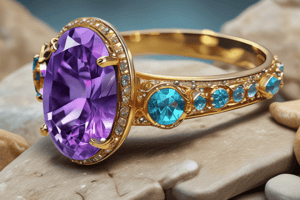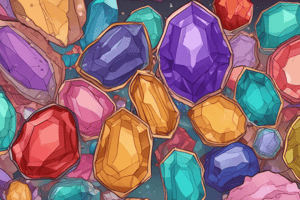Podcast
Questions and Answers
What is the purpose of disclosing treatments in the gem and jewelry industry?
What is the purpose of disclosing treatments in the gem and jewelry industry?
- To build trust in the industry (correct)
- To eliminate competition
- To increase the price of gems
- To hide the origin of the gem
Which type of treatment can change the way a gem absorbs light, altering its color?
Which type of treatment can change the way a gem absorbs light, altering its color?
- Chemical treatment
- Lattice diffusion
- Heat treatment (correct)
- Radiation treatment
What is the result of low-temperature heating on ruby and pink sapphire?
What is the result of low-temperature heating on ruby and pink sapphire?
- It creates blue color zones
- It eliminates blue color zones (correct)
- It changes the gem's clarity
- It has no effect on the color
What is required to produce blue color in geuda sapphire?
What is required to produce blue color in geuda sapphire?
What is the result of lattice diffusion with heavier elements like titanium and chromium?
What is the result of lattice diffusion with heavier elements like titanium and chromium?
What is the result of combining beryllium diffusion and heat treatment on some dark blue sapphires?
What is the result of combining beryllium diffusion and heat treatment on some dark blue sapphires?
How deep does the color resulting from lattice diffusion with beryllium penetrate into the gemstone?
How deep does the color resulting from lattice diffusion with beryllium penetrate into the gemstone?
What is the most common form of clarity enhancement?
What is the most common form of clarity enhancement?
What happens to the color of some irradiated gems when exposed to heat or light?
What happens to the color of some irradiated gems when exposed to heat or light?
What type of gem is often treated with a combination of bleaching and impregnation?
What type of gem is often treated with a combination of bleaching and impregnation?
What is the term used to describe gems with a high proportion of filler?
What is the term used to describe gems with a high proportion of filler?
Which of the following gems is NOT commonly subjected to dyeing?
Which of the following gems is NOT commonly subjected to dyeing?
What is the purpose of fracture filling in gemstone enhancement?
What is the purpose of fracture filling in gemstone enhancement?
Which of the following treatments is commonly used on pearls?
Which of the following treatments is commonly used on pearls?
Flashcards are hidden until you start studying
Study Notes
Treatments in the Gem and Jewelry Industry
- Improving gem appearance and quality through treatments increases the supply of commercially important gems.
- Disclosure of all treatments, including suspected or probable ones, is essential for building trust in the industry.
Heat Treatment
- Gems commonly subjected to heat treatment include corundum, tanzanite, zircon, topaz, aquamarine, and amber.
- Heat treatment changes the way gems absorb light, altering their color, by affecting the gain or loss of electrons in trace elements.
- Heat treatment can alter corundum color and create or eliminate phenomena and inclusions.
- Low-temperature heating can improve the appearance of ruby and pink sapphire by removing blue color zones.
- Producing blue color in geuda sapphire requires high-temperature heating in a reducing environment, followed by rapid cooling.
Lattice Diffusion
- Lattice diffusion with heavier elements like titanium and chromium produces a shallow layer of color that might be removed by minor repolishing.
- A combination of beryllium diffusion and heat treatment can improve color in some dark blue sapphires and make them more marketable.
- The color resulting from lattice diffusion with beryllium can penetrate the entire stone.
Clarity Enhancement
- Fracture filling is the most common form of clarity enhancement.
- Almost all emeralds on the market are subjected to clarity enhancement.
- Filling with glass or resin can stabilize highly fractured, otherwise unusable rough, making it suitable for jewelry use.
Other Treatments
- Irradiated color is not always stable and can be destroyed by heat or light exposure.
- Commonly irradiated gems include topaz, tourmaline, and cultured pearl.
- Bleaching is a fairly common pearl treatment, and jadeite is often treated with a combination of bleaching and impregnation.
- Dyeing is one of the oldest gem treatments, commonly used for cultured pearl, lapis lazuli, chalcedony, and coral.
Studying That Suits You
Use AI to generate personalized quizzes and flashcards to suit your learning preferences.




